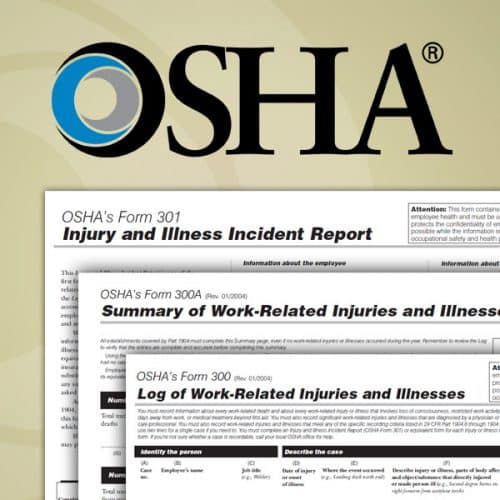
OSHA Injury Reporting
Posted on January 11, 2019 in Firm News
There are approximately 4,500,000 occupational injuries reported every year. As shocking as this statistic may appear, this number is most likely even higher. Underreported injuries in the workplace may be more common than we thought, and employers could be encouraging the behavior without even realizing it.
The Inaccuracy of Injury and Illnesses Reports
American manufacturers are required to submit a history of employee injuries and illnesses to the Occupational Health and Safety Administration (OSHA) once a year. Compiling reports using Form 300 (Log of Work-Related Injuries and Illnesses), Form 300A (Summary of Work-Related Injuries and Illnesses), and Form 301 (Injury and Illness Incident Report), employers record all reported injuries and illnesses that occur on the job. They are required to report details about the injuries such as:
- date of injury/onset of illness
- location of accident
- description of injury or illness
- outcome of injury/illness
- days away from work
- type of illness
These reports are meant to serve as tools for OSHA to gauge the effectiveness of a business’ safety policies and trainings. By analyzing trends in the reports from the current and previous years, OSHA can assess for areas of improvement based on which departments and tasks seem to result in the most accidents.
However, an article published in December 2018 by EHS Today is warning businesses not to weigh too heavily on the results of these reports when it comes to evaluating their safety success. Employers may be skewing the results of these reports by making one or more of these following mistakes that results in inaccurate reporting.
Incentivizing Not Reporting
In some businesses, employers can be so focused on the appearance of safety that they create a work culture that incentivizes employees for not reporting injuries. In October 2016, OSHA published a memorandum that stated it was banning the use of incentive programs that penalized employees for reporting injuries. Instead, companies began to lean more on programs that reward employees for accident-free periods in the workplace. But intentionally or unintentionally, employers are still encouraging workers to withhold reportable injuries and illnesses sustained on the job in order earn the promised incentive for zero accidents, creating an illusion that there are far fewer injuries in the workplace.
Employers Underreporting
OSHA inspectors take a careful look a Form 300, 300A, and 301 during site visits, scanning through each reported incident to ensure the details written make sense. Employers who are worried about OSHA violations may not provide the full details of an accident to avoid sending up red flags, or neglect to record the injury or illnesses at all. This type of reporting not only can be a huge violation in itself but can be harmful to their employees in the future if the same accidents continue to occur and no specific safety policy is set in place to prevent them.
Masking The Real Issues
Between the lack of injuries and illnesses reported and the inaccuracy of some that are, the real issues regarding safety within the manufacturing industry can be passed over. These factors make it difficult to rely on the Injury and Illness Reports to determine how safe a workplace has been over the past year, providing only a glimpse of what the actual problems could be. In addition to employers properly using these forms, the perception of these OSHA reports needs to change. Instead of employers viewing these forms as a punishment for what is going wrong, the idea that they can be used as a tool to better the workplace can be far more helpful in the long-run.
How Employers Can Comply
OSHA’s primary concern is to make sure businesses are doing their best to provide a safe work environment for their employees. EHS Health suggests that employers can help make this goal a reality by compiling with OSHA’s injury and illnesses reporting standards in the following ways:
- Prohibit any disciplinary action or retaliation for reporting injuries and illnesses.
- Remove or re-examine all workplace safety incentive programs to make sure they are not rewarding employees for non-reporting.
- Train your supervisors and managers to know how to comply with filling out the OSHA forms and the benefit they can serve to overall safety.
- Post the newest policies about non-incentivizing not reporting work injuries and illnesses in the workplace for all to understand.
- Communicate safety changes within the workforce to everyone in the company during weekly safety meetings.
- Remind employees it is their right to report an injury or illness sustained on the job.
- Talk to your employees to make sure they feel comfortable reporting and address areas of discomfort.
The law firm of Pazer, Epstein, Jaffe, and Fein have been fighting to keep workers safe in New York City for over 50 years. If you or a loved one has been injured in a workplace accident, our knowledgeable team of personal injury attorneys is ready to use our expertise to help pursue fair and reasonable compensation for your injuries. Contact us using our convenient online form or feel free to phone us in New York at 212-227-1212, or in Huntington/Long Island at 631-864-2429.
Article Source: Mark Kozeal, The Risks of Using Injury and Illness Reporting as Measurements of Success, EHS Today (December 19, 2018), https://www.ehstoday.com/safety/risks-using-injury-and-illness-reporting-measurements-success

